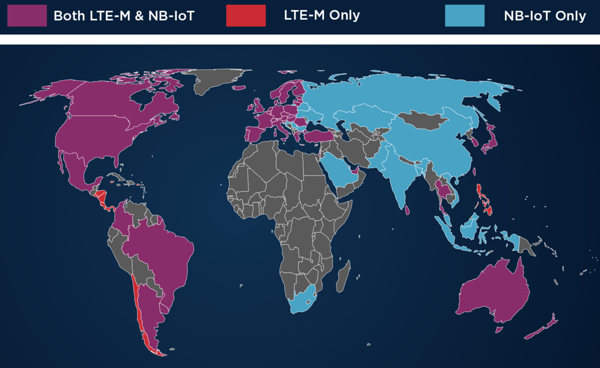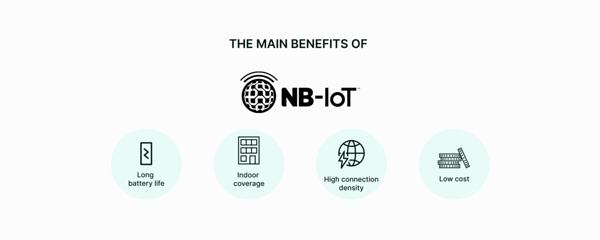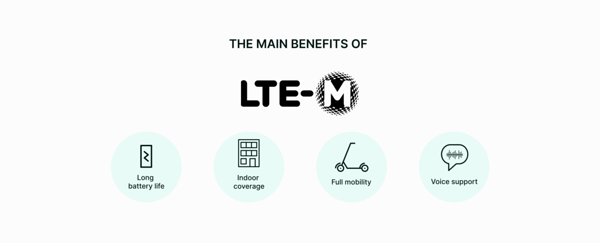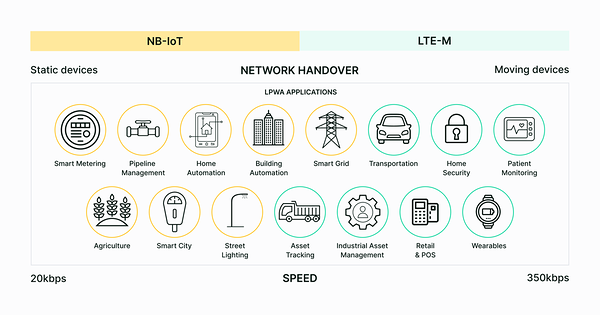LTE-M and NB-IoT are low-power wide-area networks (LPWAN) designed for the Internet of Things (IoT). Deciding on a particular technology standard is not easy, especially when considering the full spectrum of radio access technologies (RAT) such as 2G, 3G, 4G and soon 5G.
This article aims to provide an unbiased and correct comparison of the two standards based on industry research and 1oT's experience.
I will try to cut through the complexity and create an easy to understand NB-IoT and LTE-M guide to help you decide on a cellular connection.
The reality and current limitations of LPWAN
Low-power wide-area technology is relatively new. Therefore, it is important to know the current situation and future prospects. For IoT deployment, the most critical aspect is global availability.
The GSMA has a handy resource called the Mobile IoT Deployment Map. You can see the global deployment of NB-IoT and LTE-M technologies in it.
According to the latest figures, there are 162 LPWAN networks worldwide. Two-thirds of them (107) are NB-IoT networks, and the remaining 55 are LTE-M. In case of interest of availability in a specific country, I would suggest you look it up yourself. Right now, LPWAN networks exist in 62 countries.
Unfortunately, due to the lack of roaming agreements between telecom companies, your devices cannot travel from one country to another and roam freely.
If you are using your devices in multiple countries or moving from one country to another, you need to be aware of the nuances of roaming with LTE-M and NB-IoT.
If your devices are stationary and you know where they will be deployed, NB-IoT or LTE-M may be a viable option for you.
That said, NB-IoT and LTE-M are in their infancy, and it's currently helpful to have 2G or 4G fallback options.
But let's take a closer look at each technology to understand how they differ and what they are best suited for.
What is NB-IoT?
Narrowband Internet of Things (NB-IoT) is an LPWAN radio technology. Built according to the LTE standard, it limits the bandwidth to a single narrow-band of 200kHz maximum.
You might have heard the term LTE Cat-NB1 used instead of NB-IoT, but it's referring to a specification released in 2016.
Present-day, there are also Cat NB2 devices available that use the new and improved NB-IoT specifications. The main difference between this and the older version is improved downlink and uplink data rates.
It's important to note that Cat-NB2 devices provide better mobility - reconnection is supported also in the device connected mode, opposed to idle mode only in NB1. These categories came out with 3GPP Release 14 and are currently on the road towards commercialisation.
Although NB-IoT and LTE-M are types of cellular connection and are sometimes even referred to as "Mobile IoT", these terms can be confusing. Cellular means that they use cellular technologies.
NB-IoT can be deployed "in-band" within a standard LTE carrier or "standalone" for deployments in the dedicated spectrum. It means that even though NB-IoT can perfectly co-exist with 2G, 3G, and 4G in a device, devices currently operating on 2G, 3G, and 4G don't automatically support NB-IoT.
NB-IoT is designed to work with so-called constrained devices. These devices have serious processing power, network connectivity, or battery life limitations. NB-IoT has considerable benefits in indoor coverage, low cost, long battery life and high connection density.
That means it's perfect for your devices located in buildings, remote and hard to reach locations and even underground to an extent. NB-IoT supports an excellent battery life for many use cases, possibly exceeding a 10-year mark.
Taking a look in the future, according to ABI Research, NB-IoT and LTE-M will capture over 60% of the 3.6 billion LPWA network connections by 2026.
What is LTE-M?
LTE-M (abbreviation for LTE Cat-M1/M2) is, just like NB-IoT, an alternative LPWAN technology. This technology is created for IoT devices to connect directly to a 4G network, without a gateway and using only batteries. It's important to note that it only means that LTE-M is a build-up on 4G and doesn't mean that any 4G device automatically supports LTE-M.
Machine Type Communication (eMTC) is also included with LTE-M.
LTE-M shares a few similar qualities with NB-IoT. It is designed to support a longer device life. A device's battery is expected to last up to 10 years. Also, LTE-M can perfectly co-exist with 2G, 3G, and 4G and benefits from all mobile networks' security and privacy features.
I know that making a difference between LTE CAT-M1 and LTE CAT-M2 can be confusing.
The main difference comes in terms of data transmission bandwidths. While LTE Cat M1 transmitted data at a bandwidth of 1.4 MHz, LTE Cat M2 will increase it to 5 MHz. This increases LTE Cat M2 data throughput to peak rates of 4Mb/s for downloads and 7Mb/s for uploads, broadening the appeal of LTE-M even for relatively high data speed applications such as video surveillance.
As an advantage for LTE CAT-M2, at these download and upload speeds, it will also be much faster to deliver remote firmware updates over-the-air (OTA) than it was with LTE CAT-M1 or would be with NB-IoT, limiting drain on the battery.
LTE-M and NB-IoT comparison
LPWAN is gaining a lot of interest because of the low cost of required cellular hardware.
NB-IoT or LTE-M modules are the cheapest cellular modules on the market. Hence, companies tend to look for LPWAN connectivity but forget to consider the functionality and use-case in addition to hardware cost.
So, let's compare both standards in terms of specific aspects such as
- power consumption
- mobility
- data speed
- suitability for eSIM
-
voice availability
It will also help you decide if one of the LPWAN technologies is suitable for your deployment.
Power consumption
NB-IoT and LTE-M represent a significant improvement in power consumption compared to other cellular standards. However, comparing the two IoT connectivity solutions is difficult due to the many factors that affect power consumption and, therefore, battery life.
Both technologies support PSM (power saving mode) and eDRX (extended discontinuous reception), which extend battery life. You may ask, how?
IoT devices usually send or receive data intermittently. LPWAN allows a device and SIM to go to sleep mode between sending and receiving data to minimise power consumption. Otherwise, a high energy cost is associated with a device detaching from the network and then re-attaching.
The power consumption of NB-IoT and LTE-M depends on your specific use case and the devices you use. Whether you choose eDRX or PSM or use both depends entirely on your use case. 1oT recommends thoroughly testing all three options (eDRX alone, PSM alone, and eDRX and PSM together) to determine which method provides the best power savings for your application.
The most crucial point is that you do not misconfigure the sleep period between the wake-respond-sleep cycle so that your device cannot send data or function as it should.
Mobility
When your devices move around, the SIM needs to switch between cell towers. While NB-IoT can keep devices connected while they move, NB-IoT is not capable of cell tower handover.
When the device moves away from a cell tower, it increases the device's power consumption to try to connect until it is entirely in the dark. Once disconnected, the device must re-register with the network, increasing power consumption.
LTE-M works like 4G and supports seamless switching between cell towers while saving power. It supports full mobility and in-vehicle handover, meaning it's well-suited for mobile use cases with medium data rate needs, such as vehicle and asset tracking, fleet management etc.
LTE-M is, therefore, suitable for both stationary and mobile devices, while NB-IoT is only suitable for stationary devices.
Data speeds
Both NB-IoT and LTE-M have limited data transmission. Whether your device needs to download or upload data, the maximum data speed is only a fraction of conventional RAT types. LTE-M has the edge in speed.
Therefore, neither device is a good option for applications that require more data.
| LTE-M | NB-IoT | |
| Download speed | 1 Mbit/s (Cat-M1) 4 Mbit/s (Cat-M2) | 26 kbit/s (Cat-NB1) 127 kbit/s (Cat-NB2) |
| Upload speed | 1 Mbit/s (Cat-M1) 7 Mbit/s (Cat-M2) | 66 kbit/s (Cat-NB1) 159 kbit/s (Cat-NB2) |
Another thing important to note here when looking into getting an either NB-IoT or LTE-M SIM card is your device's monthly data consumption. When the threshold for NB-IoT is usually around 1MB/month, then LTE-M can cover more data-hungry applications.
eSIM compatibility
Both LTE-M and NB-IoT are technically supported by eSIM. The only consideration point is that the NB-IoT specification does not have SMS services as a requirement. SMS protocol is used for eSIM transactions.
Many operators still have included SMS support in NB-IoT, but this can not be guaranteed. There are no SMS limitations on LTE-M.
Voice availability
One significant benefit of LTE-M is the support of voice functionality via VoLTE (voice over LTE). That means it can be used for applications requiring a level of human interaction, such as for health and security applications (for example, stay‑in‑place solutions and alarm panels).
Unfortunately, that can't be said about NB-IoT, which doesn't support voice functionality.
Conclusion
NB-IoT and LTE-M are optimised for devices that consume small amounts of data over long periods. The advantage of LTE-M and NB-IoT is longer battery life, which means a higher return on investment (ROI) and overall value to the business case.
No one has a crystal ball, so it's impossible to say which LPWAN technology will be most successful. But looking at current (and future) statistics, both LTE-M and NB-IoT can have clear advantages in certain situations. Because of its maturity, we think LTE-M is better suited for full-fledged commercial applications.
LTE-M is the more flexible of the two solutions. It is a solid, future-proof choice for connectivity, as it is suitable for both fixed and mobile devices. However, NB-IoT is more suitable for manufacturers with fixed devices for known countries where not much data is sent. In this case, stationary devices using NB -IoT can have years of battery life thanks to the power saving features.
I hope this blog has helped you learn more about the differences between these two standards and their suitable application. If you have any further questions, please do not hesitate to contact us at sales@1oT.com.







